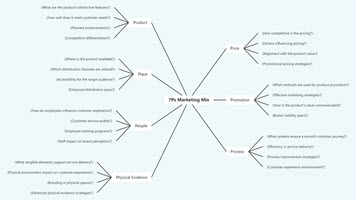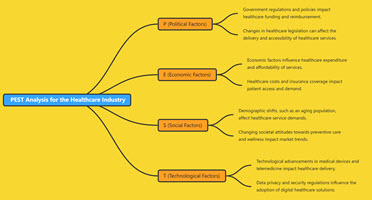Introduction to Mind Mapping
Mind mapping is a powerful visual thinking tool that helps you structure information, allowing you to better analyze, comprehend, synthesize, recall, and generate new ideas. It involves creating a diagram that represents tasks, words, concepts, or items linked to and arranged around a central concept or subject using a non-linear graphical layout. This technique allows you to break down complex information into smaller, more manageable parts, making it easier to understand and remember.
Key Concepts of Mind Mapping
Visual Representation
Mind maps present key ideas, concepts, and relationships in a concise and organized format. This visual approach simplifies complex information by presenting it in a clear, structured, and easily digestible manner. By using visual elements such as colors, images, and symbols, mind maps engage both the left and right hemispheres of the brain, enhancing memory retention and creative thinking.
Hierarchical Structure
A mind map typically starts with a central idea or concept placed in the middle of the page. From this central idea, main branches radiate outwards, representing the key subtopics or categories. Each of these main branches can further branch out into sub-branches, creating a hierarchical structure that allows you to break down complex topics or projects into smaller, more manageable components. This structure helps you navigate through the mind map and focus on specific areas of interest.
Why Use Mind Mapping?
Mind mapping offers numerous benefits, including:
- Improved Memory Retention: By engaging both the left and right hemispheres of the brain, mind maps enhance memory retention and recall.
- Enhanced Creativity: The non-linear structure of mind maps encourages creative thinking and the generation of new ideas.
- Better Organization: Mind maps help you organize information in a structured and logical manner, making it easier to understand and navigate.
- Effective Problem-Solving: By breaking down complex problems into smaller, more manageable parts, mind maps facilitate effective problem-solving and decision-making.
- Efficient Planning: Mind maps are excellent tools for planning projects, presentations, and essays, allowing you to visualize the entire process and identify key steps and milestones.
When to Use Mind Mapping
Mind mapping can be used in various scenarios, including:
- Brainstorming: Generate and capture ideas quickly and efficiently during brainstorming sessions.
- Studying: Organize and review notes, concepts, and relationships for better understanding and recall.
- Project Planning: Visualize project goals, tasks, and timelines for effective planning and execution.
- Problem-Solving: Break down complex problems into smaller, more manageable parts for easier analysis and resolution.
- Presentations: Create engaging and informative presentations by organizing content in a visually appealing and easy-to-follow format.
How to Use Visual Paradigm Online’s Smart Board for Mind Mapping
Visual Paradigm Online’s Smart Board is a comprehensive mind mapping tool and brainstorming app that offers a wide range of features to help you create effective mind maps. Here’s how to use it:
Getting Started
- Sign Up: Visit the Visual Paradigm Online website and sign up for a free account. No credit card is required, and there are no hidden charges.
- Choose a Template: Explore the template oasis and select a predefined framework that suits your needs. Smart Board offers various templates, including mind maps, family trees, concept maps, org charts, brace maps, fishbone diagrams, tree charts, and bubble maps.
- Customize Your Mind Map: Use the captivating styles, fonts, colors, and formatting choices to personalize your mind map and make it visually appealing.
- Organize Information: Arrange your ideas and information in a hierarchical structure, with the central idea in the middle and main branches radiating outwards.
- Save and Share: Utilize the cloud storage feature to access your mind maps anytime, anywhere, and effortlessly share files with others.
Example: Personal Finance Mind Map
Let’s create a mind map for personal finance using Visual Paradigm Online’s Smart Board.
- Central Idea: Personal Finance
- Main Branches:
- Retirement Planning
- Investing
- Budgeting
- Taxes
- Insurance
- Sub-Branches:
- Retirement Planning: 401(K), IRA, Social Security, Pension, Annuities
- Investing: Stocks, Bonds, Mutual Funds, Exchange-traded funds, Real Estate
- Budgeting: Income, Expenses, Savings, Debt Management
- Taxes: Income Tax, Property Tax, Sales Tax, Estate Tax, Gift Tax
- Insurance: Health Insurance, Life Insurance, Disability Insurance, Long-Term Care Insurance, Homeowners Insurance
By organizing personal finance concepts in a mind map, you can better understand the relationships between different aspects and make informed decisions about your financial future.
Example: Why Visual Paradigm
Visual Paradigm
- Preferred Tool
- Globally: Visual Paradigm is preferred by enterprises around the world.
- Fortune 500 Companies: Used by leading corporations.
- Startups: Adopted by innovative startups.
- Government Agencies: Utilized by government entities.
- Features
- Powerful: Offers robust and advanced features.
- User-Friendly Design: Intuitive and easy to use.
- Excellent Choice
- Rapid EA Modeling: Enables fast enterprise architecture modeling.
- Collaborative EA Modeling: Facilitates team collaboration in EA modeling.
- ArchiMate Modeling Tools
- Complete Solution: Provides a comprehensive solution for enterprise architecture design.
- Easy-to-Use: User-friendly and accessible.
- Enterprise Architecture Design: Ideal for designing enterprise architectures.
- Certified Tools: Tools are certified for quality and reliability.
- Advanced Capabilities: Offers cutting-edge features and functionalities.
- Collaborative Environment: Promotes teamwork and collaboration.
- Leading Option
- Streamline Architectural Processes: Helps businesses streamline their architectural processes.
This description breaks down the key points from the conclusion into a structured format, highlighting the various aspects of Visual Paradigm and its ArchiMate modeling tools.

Example 2: Personal Finance
Personal Finance
- Retirement Planning
- 401(K): A type of retirement savings account offered by many employers.
- IRA (Individual Retirement Account): A personal retirement savings plan.
- Social Security: A federal program providing retirement benefits.
- Pension: A retirement plan that provides a fixed income.
- Annuities: Financial products that provide a steady income stream during retirement.
- Investing
- Stocks: Shares in the ownership of a company.
- Bonds: Debt securities issued by corporations or governments.
- Mutual Funds: Investment vehicles that pool money from many investors to purchase a diversified portfolio of stocks, bonds, or other securities.
- Exchange-Traded Funds (ETFs): Investment funds traded on stock exchanges.
- Real Estate: Property investments including residential, commercial, and land.
- Budgeting
- Income: Money earned from employment, investments, or other sources.
- Expenses: Costs incurred for goods, services, and living expenses.
- Savings: Money set aside for future use or emergencies.
- Debt Management: Strategies for managing and reducing debt.
- Taxes
- Income Tax: Taxes levied on personal income.
- Property Tax: Taxes on real estate and personal property.
- Sales Tax: Taxes on the sale of goods and services.
- Estate Tax: Taxes on the transfer of property at death.
- Gift Tax: Taxes on the transfer of property during life.
- Insurance
- Health Insurance: Coverage for medical and health-related expenses.
- Life Insurance: Coverage that pays a benefit upon the death of the insured.
- Disability Insurance: Coverage for income replacement if the insured becomes disabled.
- Long-Term Care Insurance: Coverage for long-term care services and support.
- Homeowners Insurance: Coverage for damage to or loss of a home and its contents.
This description outlines the key components of personal finance as depicted in the mind map, providing a clear and structured overview of each category and its subcategories.

Conclusion
Mind mapping is a powerful tool for visualizing, organizing, and understanding complex information. With Visual Paradigm Online’s Smart Board, you can create engaging and effective mind maps to enhance your creativity, memory retention, and problem-solving skills. Whether you’re planning a project, organizing your thoughts, or solving intricate problems, Smart Board has the features and templates to help you succeed. So, why wait? Begin crafting your mind map now and experience the true power of visual mind mapping.

Five Forces Analysis

PEST Analysis

PESTLE Analysis

Ansoff Matrix

MoSCoW Matrix

Value Chain Analysis

McKinsey 7-S Framework

Business Model Canvas

5 Whys Analysis

PDCA (Plan-Do-Check-Act)

Total Quality Management

4P Marketing Mix

7Ps Marketing Mix

Decision Making

Meeting Agenda

5W’s (Who, What, Where, When, Why)

5W1H

5W’s For Implementation of Renewable Energy in a Small Town

Meeting Agenda For Implementing a New Project Management Software

7Ps of Marketing for a Coffee Shop

Total Quality Management for a Manufacturing Company

Value Chain Analysis for a Software Development Company

Why is there a decline in vehicle sales for a specific car model?

Business Model Canvas for an E-commerce Platform

McKinsey 7-S Framework for Value Chain Analysis in the Retail Industry

Five Forces Analysis for the Electric Vehicle Industry

PEST Analysis for the Healthcare Industry

5W’s for Reducing Medication Errors

5W’s for Improving Customer Satisfaction in the Hospitality Industry

5W’s for Optimizing Supply Chain Efficiency in the Manufacturing Industry

5W’s for Implementing Sustainability Initiatives in the Fashion Industry

5W’s for Enhancing Cybersecurity in the Banking Sector

5W’s for Improving Educational Outcomes in Underserved Communities

5W’s for Implementing Remote Work Policies in the Technology Sector

5W’s for Reducing Food Waste in the Restaurant Industry

5W’s for Improving Employee Engagement in the Retail Industry

Meeting Agenda for Implementing a New Project Management System

Meeting Agenda for Launching a Marketing Campaign

Meeting Agenda for Creating a Roadmap for Developing a New Product

